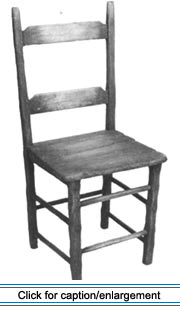|
Like textiles and textile production tools, traditional, locally made
furniture is well represented in Valley museum and private collections.
In their form and construction, these pieces of furniture show a remarkable
resiliency through time and stand as important products of the Valleyís
household-based economy. Churchill and McDonald studied the furniture
of the Valley for an exhibit at the Maine State Museum, and much of the
following is from their work (1988).
 Throughout
the 19th century, Maine Acadians created traditional furniture using hand
tools. Construction relied on basic frame-and-panel joinery techniques
brought to French Canada and Acadia from 17th-century France. These methods
were subsequently employed by migrants to the Valley, where joined furniture
construction persisted far later than in neighboring New England and much
of Canada where traditional methods had been replaced by later cabinet-making
techniques. Throughout
the 19th century, Maine Acadians created traditional furniture using hand
tools. Construction relied on basic frame-and-panel joinery techniques
brought to French Canada and Acadia from 17th-century France. These methods
were subsequently employed by migrants to the Valley, where joined furniture
construction persisted far later than in neighboring New England and much
of Canada where traditional methods had been replaced by later cabinet-making
techniques.
The traditions brought to the Valley in the late 18th century were maintained
within the province of the household until the early decades of the 20th
century. As with textile production, techniques and tools for making furniture
were transferred from generation to generation.
 Side
chairs with plank seats, squared legs and posts, and through-mortised
back slats are the most frequently encountered type of traditional furniture
in Valley collections. Always painted and sometimes featuring chamfered
legs and posts, these chairs exhibit a remarkable stylistic similarity.
Long benches represent another traditional form of seating and, along
with chairs and large tables, they accommodated the Valleyís large families
very well. Blanche Collin of St. Agathe recalls that when her family gathered
for meals during her childhood in the 1920s and 1930s, her father was
seated at the head of the table, the younger children were seated on benches
placed along one side and one end, and her mother and the older children
were on chairs along the other side. When Mrs. Collin later had her own
family, she had benches made and used the same seating pattern in her
home. Side
chairs with plank seats, squared legs and posts, and through-mortised
back slats are the most frequently encountered type of traditional furniture
in Valley collections. Always painted and sometimes featuring chamfered
legs and posts, these chairs exhibit a remarkable stylistic similarity.
Long benches represent another traditional form of seating and, along
with chairs and large tables, they accommodated the Valleyís large families
very well. Blanche Collin of St. Agathe recalls that when her family gathered
for meals during her childhood in the 1920s and 1930s, her father was
seated at the head of the table, the younger children were seated on benches
placed along one side and one end, and her mother and the older children
were on chairs along the other side. When Mrs. Collin later had her own
family, she had benches made and used the same seating pattern in her
home.
Some traditional Valley furniture, such as tables, chairs, benches, and
chests, filled very practical purposes. They show largely straightforward
construction techniques and stylistic uniformity, as well as evidence
of wear and replacement of worn parts. Other types of furniture reflect
more complex influences not seen in the more utilitarian furniture. Armoires,
for example, with their boldly shaped cornices and raised panels, are
similar to pieces in French Canada. Moreover, some of these same pieces
bear hallmarks of Acadian furniture in Louisiana, as observed by Brassieur
(1992):
|
 |
 |
- raised-panel doors with the beveled (raised) side of the panel facing
inside, and a smooth-planed or sawn surface facing outside of the door;
- raised-panel doors joined by through-cut mortise and tenons, with
tenons often held in place by two wooden pegs per joint;
- predominance of short pieces such as armoires, armoirettes, chests
of drawers, garde-manger, and buffets;
- simple curved trim between the feet of the piece;
- painted surfaces, often red, called gros rouge in Louisiana
and sang de boeuf in the Upper St. John Valley;
- use of local softwoodsócypress and pine in Louisiana, pine and cedar
in the Upper St. John Valleyórarely in combination with hardwoods;
- older drawers or chests joined with small, widely spaced, hand-cut
dovetails, many of which have been tightened by the addition of thin
wooden shims or wedges.
 As
the railroad and mail-order catalogs brought more influences to the St.
John Valley in the early 1900s, traditional furniture continued its evolution.
However, instead of exhibiting a shift in style, traditional furniture
gradually disappeared as it was replaced by manufactured furnishings. As
the railroad and mail-order catalogs brought more influences to the St.
John Valley in the early 1900s, traditional furniture continued its evolution.
However, instead of exhibiting a shift in style, traditional furniture
gradually disappeared as it was replaced by manufactured furnishings.
By 1940, for example, most of the furniture in the Fred Albert house
in St. David parish had been manufactured outside the Valley. But the
kitchen and dining room still had handmade tables and two traditional
rocking chairs. In other households, newlyweds received handmade pieces
with which to set up housekeeping, but only kept those pieces until they
could afford manufactured substitutes. Fire victims were also recipients
of traditional furniture, as evidenced in the Donat Cyr home in Lille,
Grand Isle, in 1938. All that was saved from the house after the fire
was a back shed that contained several pieces of traditional furniture.
When a new house was built, an old armoire was set in the kitchen, and
several traditional beds were put back into use. In a few years, these
pieces were replaced, the beds by manufactured items, the armoire by a
refrigerator.
 Still,
some local production of furniture, drawing both on traditional techniques
and new influences from outside the Valley, occurred in the 20th century.
Paradoxically, this type of locally produced furniture was not a traditional
Valley form, but one introduced to the region in the late 1800s: the rocking
chair. The rocking chair achieved rapid and widespread acceptance throughout
the St. John Valley in the 20th century. People purchased them from commercial
suppliers, traditional chairs were modified by adding rockers, or new
rocking chairs were made locally. Still,
some local production of furniture, drawing both on traditional techniques
and new influences from outside the Valley, occurred in the 20th century.
Paradoxically, this type of locally produced furniture was not a traditional
Valley form, but one introduced to the region in the late 1800s: the rocking
chair. The rocking chair achieved rapid and widespread acceptance throughout
the St. John Valley in the 20th century. People purchased them from commercial
suppliers, traditional chairs were modified by adding rockers, or new
rocking chairs were made locally.
In producing these new pieces, local makers often combined traditional
and manufactured elements, or sometimes departed from both forms to produce
their individual expressions. Rocking chair backs were particularly individualized.
Despite these variations, virtually all Valley rockers examined in local
collections share a common elementóon chair after chair, the frame, stretcher,
and seat are wholly traditional in their form and construction.
The contrast between the backs and the bases of locally made rocking
chairs shows the dynamics between stability and change in a local tradition.
Manufactured furniture highlighted other possibilities for the design
of rocking chairs, and the makers of the chairs responded by adopting
or creating innovative backs for the rocking chairs that they made. When
it came time to make the frame and seat, however, the basic construction
was done with traditional techniques. Rocking chairs, then, may reflect
not only changes in Acadian material culture, but also an overall shift
in life patterns as Maine Acadian culture moved through the 20th century.
|
|

